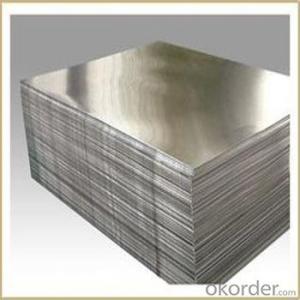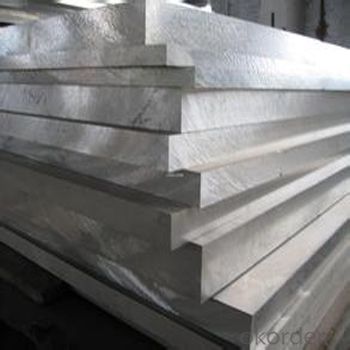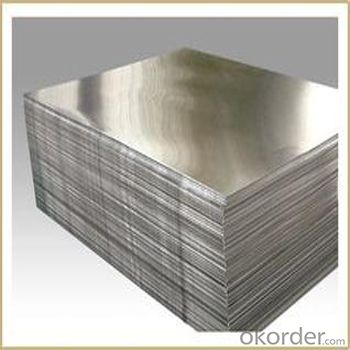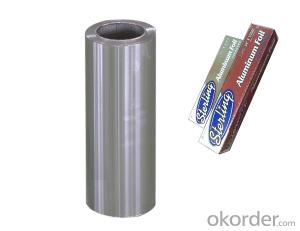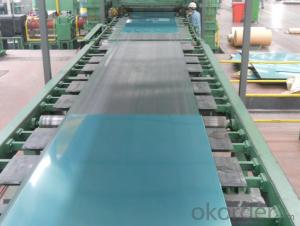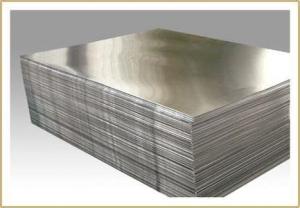Marine Grade Aluminum Sheets, Plates, and Boards
- Loading Port:
- Shanghai
- Payment Terms:
- TT OR LC
- Min Order Qty:
- 1 m.t.
- Supply Capability:
- 100 m.t./month
OKorder Service Pledge
OKorder Financial Service
You Might Also Like
1.Specification
ALLOY: AA1*** (AA1050,AA1060,AA1070,AA1100 etc.)
AA3*** (AA3003,AA3004,AA3005,AA3105 etc.)
AA5*** (AA5052,AA5083,AA5754 etc)
AA8*** (AA8011,AA8006 etc)
TEMPER: H14,H16,H18,H22,H24,H26,H32,O/F
THICKNESS: 0.2mm-100mm
WIDTH: 30mm-1700mm
STANDARD: GB/T 3880-2006
Special specification is available on customer's requirement
2.Description
Aluminium is oxidized by water at temperatures below 280°C to produce hydrogen, aluminium hydroxide and heat:2 Al + 6 H2O → 2 Al(OH)3 + 3 H2
This conversion is of interest for the production of hydrogen. Challenges include circumventing the formed oxide layer, which inhibits the reaction and the expenses associated with the storage of energy by regeneration of the Al metal.
Aluminium is theoretically 100% recyclable without any loss of its natural qualities. According to the International Resource Panel's Metal Stocks in Society report, the global per capita stock of aluminium in use in society (i.e. in cars, buildings, electronics etc.) is 80 kg (180 lb). Much of this is in more-developed countries (350–500 kg (770–1,100 lb) per capita) rather than less-developed countries (35 kg (77 lb) per capita). Knowing the per capita stocks and their approximate lifespans is important for planning recycling.
3.Our advantage
We can supply the best quality!
4.Pictures


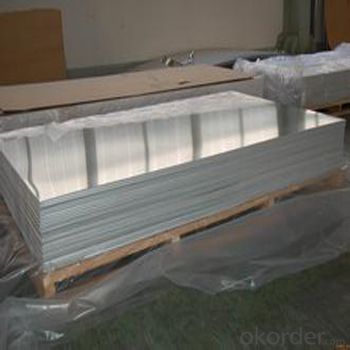
5.FAQ
1)what is aluminum?
Aluminium (or aluminum; see spelling differences) is a chemical element in the boron group with symbol Al and atomic number 13. It is a silvery white, soft, nonmagnetic, ductile metal. Aluminium is the third most abundant element (after oxygen and silicon), and the most abundant metal in the Earth's crust. It makes up about 8% by weight of the Earth's solid surface.
Aluminium metal is so chemically reactive that native specimens are rare and limited to extreme reducing environments. Instead, it is found combined in over 270 different minerals.The chief ore of aluminium is bauxite.
2)What's kind of payment term we can supply?
CIF,CFR, FOB and other.
3)Can we supply samples?
Yes, we can!
4)What can you do if you have other quastions?
You can contact us freely at any time!
- Q: Where is the difference between the 5052 aluminum plate and the 1060 Aluminum plate?
- Ingredients:5052 alloy aluminum (aluminum magnesium alloy, aluminum content of about 95%, magnesium content of about 4%, as well as some other trace metal elements)1060 is pure aluminum (aluminum containing 99.6%, margin for other metal elements)Physical property:Similarly, the two kinds of aluminum, 5052 to 1060 higher in hardness, elongation, tensile strength and so on are not the same. What are the specific states (H14, H32, H24, O, etc.)?Prices are usually 5052 above 1060. How much specific higher, according to different manufacturers and production processes vary.
- Q: Are aluminum sheets suitable for transportation applications?
- Yes, aluminum sheets are suitable for transportation applications. Aluminum is a lightweight and strong material, making it ideal for various transportation purposes. It is commonly used in the aerospace industry for constructing aircraft structures, as well as in the automotive industry for manufacturing vehicle bodies, frames, and components. The use of aluminum sheets in transportation applications helps to reduce the overall weight of vehicles, which can improve fuel efficiency and increase payload capacity. Additionally, aluminum is resistant to corrosion, making it durable and long-lasting, even in harsh environments. Overall, the properties of aluminum sheets make them a suitable choice for transportation applications.
- Q: I need to know what composite bats do and how (or if) they are better than aluminum bats.
- This Site Might Help You. RE: What is the difference between composite bats and aluminum bats? I need to know what composite bats do and how (or if) they are better than aluminum bats.
- Q: What are the different types of surface treatments available for painted aluminum sheets?
- There are several types of surface treatments available for painted aluminum sheets, including anodizing, powder coating, and laminating. Anodizing involves creating a protective oxide layer on the surface of the aluminum, providing enhanced durability and corrosion resistance. Powder coating involves applying a dry powder onto the aluminum surface and curing it to create a durable and decorative finish. Laminating involves applying a protective film onto the painted aluminum sheet, providing additional protection against scratches and UV radiation.
- Q: Can aluminum sheets be used for lithographic printing?
- Indeed, lithographic printing can make use of aluminum sheets. This widely-used printing method, also referred to as offset printing, involves the transfer of an image from a plate onto a rubber blanket and subsequently onto the printing surface. Aluminum sheets are frequently employed as the foundational material for lithographic plates due to their exceptional durability, lightweight composition, and capacity to retain intricate details. Typically, these aluminum sheets utilized in lithographic printing are coated with a photosensitive emulsion, facilitating the precise and accurate transfer of the image onto the printing surface. Consequently, aluminum sheets represent an optimal selection for lithographic printing, particularly for extensive and high-quality printing endeavors.
- Q: What is the flexural modulus of aluminum sheets?
- The measure of the stiffness or rigidity of aluminum sheets when subjected to bending or flexural stress is referred to as the flexural modulus. This mechanical property quantifies the aluminum sheet's resistance to deformation under applied force. Typically ranging between 69 GPa to 79 GPa, the flexural modulus of aluminum sheets depends on the specific alloy and temper. However, it is crucial to note that factors such as thickness, heat treatment, and manufacturing processes can cause slight variations in the flexural modulus. Aluminum is widely recognized for its exceptional strength-to-weight ratio, making it a favored choice for applications that require lightweight and durable materials. Due to its relatively high flexural modulus, aluminum sheets can maintain their shape and resist bending or flexing, making them suitable for uses in aircraft structures, automotive components, and building construction. It is important to highlight that the flexural modulus of aluminum can be improved through alloying elements or heat treatment processes. For instance, certain aluminum alloys like 7075 or 2024 may exhibit higher flexural modulus values due to their enhanced strength and stiffness properties. To summarize, the flexural modulus of aluminum sheets is a crucial mechanical property that determines their ability to withstand bending or flexural stress. This property provides valuable insights into the material's rigidity and assists engineers and designers in selecting the appropriate aluminum alloy and thickness for various applications.
- Q: Are aluminum sheets suitable for thermal insulation?
- No, aluminum sheets are not suitable for thermal insulation on their own. While aluminum is a good conductor of heat and electricity, it does not have good insulating properties. In fact, aluminum sheets can actually transfer heat instead of blocking it, making them ineffective for thermal insulation purposes. For proper thermal insulation, materials with low thermal conductivity, such as fiberglass, mineral wool, or foam boards, are commonly used. These materials are designed to trap air or create a barrier that reduces the transfer of heat, ensuring effective insulation.
- Q: Are aluminum sheets suitable for use in marine or saltwater environments?
- Yes, aluminum sheets are suitable for use in marine or saltwater environments. Aluminum has excellent corrosion resistance properties and is known for its ability to withstand the harsh conditions found in marine environments. Unlike many other metals, aluminum forms a protective oxide layer on its surface when exposed to oxygen, which helps prevent further corrosion. This oxide layer acts as a barrier, protecting the underlying metal from saltwater and other corrosive elements. Additionally, aluminum is lightweight yet strong, making it an ideal choice for marine applications where weight reduction is important. It is commonly used in the construction of boats, ships, offshore structures, and other marine equipment.
- Q: Are the aluminum sheets suitable for manufacturing chemical storage cabinets?
- Indeed, chemical storage cabinets can be manufactured with aluminum sheets. Aluminum, being a robust and long-lasting material, exhibits corrosion resistance, thus making it an excellent choice for safeguarding chemicals. Its lightweight nature renders transportation and installation more convenient. Moreover, aluminum remains non-reactive with the majority of chemicals, thereby ensuring the safety of stored substances. In summary, the utilization of aluminum sheets offers a dependable and effective solution for the production of chemical storage cabinets.
- Q: Can aluminum sheet be anodized?
- Yes, aluminum sheet can be anodized. Anodizing is an electrochemical process that enhances the natural oxide layer on the surface of aluminum, making it thicker, more durable, and better suited for various applications. The process involves immersing the aluminum sheet into an electrolyte solution and passing an electric current through it. This causes oxygen ions to be released from the electrolyte and bond with the aluminum, forming a new layer of aluminum oxide. Anodizing can be used to create a range of colors on the surface of the aluminum sheet, as well as improve its corrosion resistance and provide a better surface for adhesion of paints or coatings.
Send your message to us
Marine Grade Aluminum Sheets, Plates, and Boards
- Loading Port:
- Shanghai
- Payment Terms:
- TT OR LC
- Min Order Qty:
- 1 m.t.
- Supply Capability:
- 100 m.t./month
OKorder Service Pledge
OKorder Financial Service
Similar products
Hot products
Hot Searches
Related keywords

